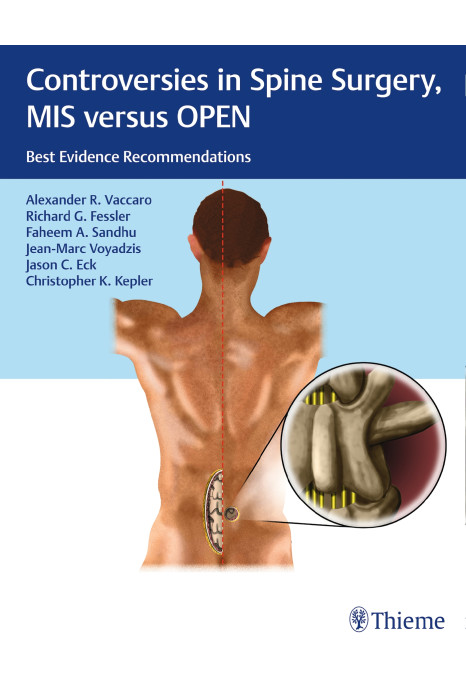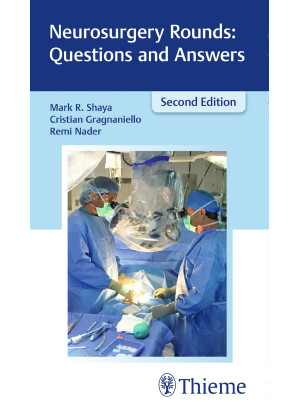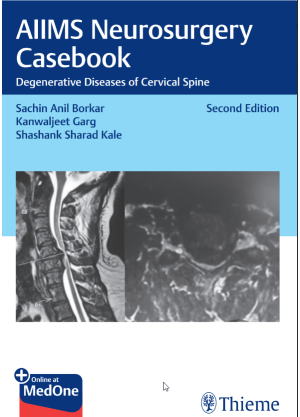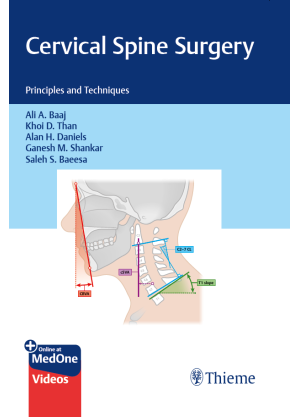Master spine surgeons Alexander R. Vaccaro, Richard G. Fessler, and a cadre of esteemed co-editors have compiled the most comprehensive textbook to date detailing minimally invasive spine (MIS) versus open spine surgery techniques. Controversies in Spine Surgery, MIS versus OPEN: Best Evidence Recommendations features debates by renowned experts on one of the most provocative topics in spine surgery. Twenty-four chapters systematically organized into four sections — degenerative, trauma, tumor, and other issues, cover procedures and underlying pathologies, backed by a large, diverse body of literature.
MIS and open approaches are thoroughly compared and contrasted in each chapter. Evidence is presented and analyzed in an objective manner with 'opposing sides' presenting differing opinions and techniques, resulting in a synchronous collection of pros and cons. Every chapter is masterfully summed up by the book's editors — each of whom have varying stances on the topics at hand. This unique 'duel' and 'duet' discussion enables readers to assimilate information, benefit from the balanced harmony between divergent opinions, and reach their own conclusions.
Key Highlights
- Comparative risks, benefits, complications, and outcomes for a full spectrum of lumbar, thoracic and cervical procedures
- MIS versus open approaches for lumbar stenosis, synovial cysts, lumbar adjacent segment degeneration, degenerative scoliosis, flatback syndrome, thoracic disc herniation, and dural tears
- Tumor resection and stabilization, quality of life issues, and potential advantages and risks of MIS techniques
- Key differences in MIS versus open operations such as radiation exposure and costs
- Analysis of 3-D navigational imaging to improve outcomes and reduce radiation exposure and operating time
This book is a tremendous, evidence-based tool to guide spine surgeons as they make important decisions on selecting the most optimal spine surgery techniques. It is a must-have resource for all resident and veteran orthopaedic surgeons and neurosurgeons who specialize in treating patients with spine conditions.
Part I: Degenerative
1 Lumbar Discectomy: Is Tubular or Endoscopic Discectomy Better Than Traditional Microdiscectomies?
2 Is Lumbar Stenosis Best Treated with an Open Laminectomy?
3 Facet Cysts: Is There an Advantage to Treating Synovial Cysts with Minimally Invasive Techniques?
4 Transforaminal Lumbar Interbody Fusion: Minimally Invasive versus Open
5 The Lateral Transpsoas Approach versus ALIF: Do the Risks of Lateral Interbody Fusion Outweigh the Benefits Compared to Anterior Lumbar Interbody Fusion?
6 Is AxiaLIF Comparable to Open Fusion with ALIF and Posterolateral 360° Fusion at L5–S1?
7 Multiple-Level Interbody Fusion: How Do Two-Level Fusion Techniques Compare between Open and Minimally Invasive Surgery?
8 Is Lumbar Adjacent Segment Degeneration Best Treated Using Minimally Invasive Surgery over Open Fusion Techniques?
9 Degenerative Scoliosis: Is There an Advantage to Using Minimally Invasive Techniques to Treat Degenerative Scoliosis?
10 Flatback Syndrome: Can Lumbar Flatback Syndrome Be Treated Adequately with Minimally Invasive Techniques?
11 Can Thoracic Disc Herniation Be Effectively Treated Using Minimally Invasive Techniques?
12 Posterior Cervical Foraminotomy
13 Complications of Instrumentation: Is There a Higher Complication Rate in Placing Instrumentation via a Minimally Invasive Technique Compared with an Open Technique?
14 Dural Tears: Should a Minimally Invasive Complication Such as a Dural Tear Routinely Be Opened for Adequate Repair or Are There Safe and Reliable Minimally Invasive Techniques for Dural Closure?
15 Do Minimally Invasive Techniques Broaden the Scope for Geriatric Spine Surgery?
Part II: Trauma
16 Thoracolumbar Burst Fractures: Can Thoracolumbar Burst Fractures Be Effectively Managed Using Minimally Invasive Surgery Techniques?
17 Open and Minimally Invasive Treatment of Cervical Spine Fractures
Part III: Tumor
18 Thoracolumbar Metastatic Tumors: Comparison of Minimally Invasive Surgery versus Open Techniques for Addressing Thoracolumbar Metastatic Tumor Resection and Stabilization
19 Intradural Spine Tumors: Is There an Advantage to Removing Intradural Spine Tumors Using an MIS Approach?
20 Quality of Life in Advanced Tumors: Can Minimally Invasive Surgery Techniques Improve the Quality of Life of Patients with Advanced Oncologic Disease to Allow for Decreased Pain or Should Traditional Techniques of Palliation Be Used?
Part IV: Other Issues
21 Radiation Exposure: How Does Radiation Exposure Differ between Open and Minimally Invasive Techniques?
22 Infection Rates: How Do Infection Rates Compare between MIS and Open Spine Techniques?
23 Cost: Which Costs More, Open or Minimally Invasive Surgery?
24 Success Rates and Time: Can Three-Dimensional Navigational Imaging Improve the Success and Time Required for Minimally Invasive Surgery and Minimize Radiation Exposure to Those in the OR Suite?











